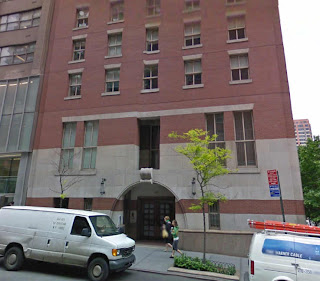 This is 243 Lexington Avenue, Brooklyn, NYC, USA, the headquarters building for Opus Dei. The opening page of The Da Vinci Code by Dan Brown lists this address as one Fact upon which the novel is based. Though I am not pro-Catholic by any means, I recognized from the time the book was published that Mr. Brown is very likely doing quite a disservice to a Catholic service organization. The very secretiveness of Opus Dei does them a disservice, which is why I prefer "daylight in every corner". Secret societies are for mental children (including my grandfather, a Mason).
This is 243 Lexington Avenue, Brooklyn, NYC, USA, the headquarters building for Opus Dei. The opening page of The Da Vinci Code by Dan Brown lists this address as one Fact upon which the novel is based. Though I am not pro-Catholic by any means, I recognized from the time the book was published that Mr. Brown is very likely doing quite a disservice to a Catholic service organization. The very secretiveness of Opus Dei does them a disservice, which is why I prefer "daylight in every corner". Secret societies are for mental children (including my grandfather, a Mason).I didn't read the book in 2003 because I wanted the hype to die down. Most of it has. Now that it is out in a Large Print paperback, I decided to read it. This won't be a usual review; thousands of reviewers have flogged this one. Rather, I'll take a riff now and again as the book triggers them.
Early in the book it is stated that the pentagram, or five-pointed star, is not a symbol of devil worship but of goddess worship, being connected to Venus. Further, that the orbit of the planet Venus traces a perfect pentagram on the sky every four years. The pentagram isn't quite that perfect, but it is pretty good. Every eight years, beginning from an inferior conjunction (closest approach of Venus to Earth), there are five more inferior conjunctions spaced around the ecliptic (or Zodiac). The sixth occurs within two degrees of the first. Two degrees isn't much, but it is four times the width of the moon on the sky, so was easily discernible by the ancients. At the end of the Pentagram article in Wikipedia there is an educational image and explanation of this ecliptic pentagram.
 While in the Louvre, Robert Langdon, apparent hero of this tale, has a flashback to a lecture about art, in which he describes the delights of PHI (or Φ), the Divine Proportion, or Golden Section. This number, an unending decimal that begins 1.618, has the property that dividing it into one yields 0.618, or Φ-1. One way to determine Φ to any precision desired is to construct the Fibonacci Series (1, 1, 2, 3, 5, 8, etc.), in which each number is the sum of the two prior numbers.
While in the Louvre, Robert Langdon, apparent hero of this tale, has a flashback to a lecture about art, in which he describes the delights of PHI (or Φ), the Divine Proportion, or Golden Section. This number, an unending decimal that begins 1.618, has the property that dividing it into one yields 0.618, or Φ-1. One way to determine Φ to any precision desired is to construct the Fibonacci Series (1, 1, 2, 3, 5, 8, etc.), in which each number is the sum of the two prior numbers.Nature is full of these numbers. This sunflower head has seeds that spiral out from the center. If you trace clockwise spirals and counter-clockwise spirals you get 34 of the first and 55 of the second, assuming you use the most open spiral in each direction. These are the ninth and tenth Fibonacci Numbers. If, for example, you select a more steeply-sloping spiral in the counter-clockwise direction, you'll find there are 21, the eighth Fibonacci Number. 55/34= 1.6176 and 34/21 = 1.6190. Both are within 0.6% of Φ. Numbers further in the sequence get you closer.
In his lecture, Langdon states several ratios found in the human body that approximate Φ, though he uses the word "exact" a little too freely. I got out a tape measure to see just how precise these ratios are. I found the following:
- My height divided by the height of my navel: 1.704, which is +5%.
- Hip height divided by knee height (where on each joint one chooses can make this quite different): Left 1.656, Right 1.644. Both are about +2%.
- Shoulder-to-fingertips divided by elbow-to-tips: Left 1.642, Right 1.616. The latter figure is very close; the other is 2% high.
- The three joints in my Left middle finger: 2.4, 1.5, 1.1 (all inches), which produces the ratios 1.600 and 1.364. Again, where you choose the joint location can make a big difference. A "near-ideal" 5-inch finger would have joint lengths of 2.5, 1.55, 0.95.
Based on the apparent ubiquity of the Divine Proportion, much is made of the Vitruvian Man diagram, in which Leonardo inscribed a human male figure into a circle in two positions. This figure's proportions are all set to Φ, making it the Ideal Figure. It would be interesting to take a tape measure to a few thousand people at random and see if the average value for a number of these ratios really does come close enough to 1.618 to constitute evidence for the Divine.
By the way, 1618/1000 reduces to 809/500. The sixteenth and seventeenth Fibonacci Numbers are 987 and 1597; their ratio is 1.61803445 which is getting pretty close to 1.61803399 (and some change), a more exact value for Φ, and a great deal more accurate than 809/500.
Now, for my title. Being a quarter of the way through the book, it appears that the Code in question is not really by Da Vinci, but by Saunière, the murdered curator. Maybe I'm wrong…



No comments:
Post a Comment